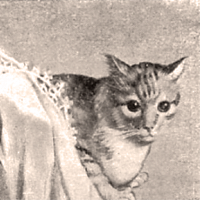A friend from Florence sent me a small piece of cotton Buratto woven by the Fondazione Lisio to test out.
This is not the modern version of Buratto that looks somewhat like burlap, this is recently hand woven fabric made in the ancient technique and on an ancient hand loom in an effort to produce a reproduction of the ancient Buratto, historically used in Italy. I told you a little about it previously in this post.
This is what the weave looks like on the Buratto from the Fondazione Lisio:
I mounted it on my slate frame which, happily was the perfect size, this piece of Buratto was 23 cm wide:
I think I may have mounted it incorrectly but it was good and taut and that's all I cared about. Then I went about experimenting.
The first motif I chose from Alessandro Paganino's 16th century pattern book called: Il Burato. I did it in a horizontal darning stitch with Coton a Broder no. 12 Ecru. Too bad I have since discovered that the no. 12 Coton a Broder in my stash is no longer available to purchase. I liked the coverage I got with the thread used.
After that I thought about Catherine de'Medici Embroidery and so I got out some Cotone Povero yarn and did a little dividing line under the Paganino motif.
Then I thought about other kinds of embroideries that were traditionally done on Buratto. Both Sicilian and Sardinian netted work came to mind so I decided to do a motif in the Linen Stitch using some Sardinian linen thread that a friend had given me. I chose a motif from GiovanAndrea Vavassore's 16th century pattern book called: Opera Nuova Universale intitolata Corona di Ricami.
Oh how I struggled with the linen thread but I think I would have even if the Buratto had been made of silk. And speaking of silk, I wanted to do my last motif in silk yarn that I have which is similar in thickness to the Cotone Povero but made of silk and viscose of Bamboo. I tried several motifs but was unhappy with the results, the silk yarn was too thick for more than one pass in Darning Stitch and looked strange for parts of the motifs where there was only one square of design.
I thought about it for a dangerously long time until it was in danger of become a UFO (unfinished object). I really wanted to use the silk/bamboo thread.
Well, I told myself, just do something in Catherine de'Medici stitch and be done! I hunted around in the Punto Madama Caterina book of patterns from the Accademia Punto Assisi and found a small motif.
The silk/bamboo thread was a dream after the linen thread but untwisted quickly and left a lot of fluff everywhere. I love the twisted-rope effect of the Catherine de'Medici stitch!
All in all, I would say that this ancient-style Buratto by the Fondazione Lisio has been given a fair test by me. It held up well to the many times I ripped out threads of all types. Now to unmount it and see what happens when I wash it!
I put my Buratto with some towels on the hand-wash cycle in the washing machine, then blocked it on a big fluffy towel face-down and ironed it dry. My blocking could have been better but here it is:
The cotton woven threads of the Buratto plumped up and so, of course, the holes got smaller. It shrunk about 2 cm from selvedge to selvedge (left and right sides in the photo) and I washed it in cold water. The Buratto is really soft after washing! My darning-stitched motif at the top is more filled-in, the silk/bamboo lost a lot of it's definition and thus I think I prefer the unwashed silk/bamboo thread better as you can see the effect of the Catherine de'Medici stitch.
I'm really impressed with the linen stitch! For all the zillions of times I ripped out and started over, the unwashed motif was uneven and you could really see the uneven thickness of the linen thread. After washing though, it looks good!
 |
| Unwashed |
 |
| Washed |
Traditional applications were things like flounces for curtains, pillows, tablecloths, inserts, ecc. I think you could also use it on clothing as it is so soft after washing. This should interest the folks who do period re-enactments.
The Fondazione Lisio has plans to try other materials like silk in future Buratto experiments. I am very glad that they have succeeded in helping to continue the ancient tradition of Buratto hand woven fabric. Watch their website for more news.
This was lots of fun! A few embroiderers were asked to participate in these experiments so I'm very interested to see everyone's results! There should be some posted soon on the TuttoRicamo blog.
A heartfelt thank you to the Fondazione Lisio for allowing me this opportunity and to my Florentine friend for thinking of me when searching out people to experiment on Buratto!











Beautiful!
ReplyDelete(Can't say anything more intelligent than that...not into textiles as such) - but this is very cool.
Cara, the 'florentine friend' è stata entusiasta quanto voi ricamatrici per questa avventura! E non ho mai avuto dubbi che i risultati sarebbero stati eccellenti.
ReplyDelete